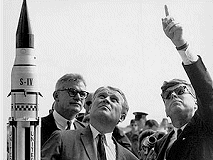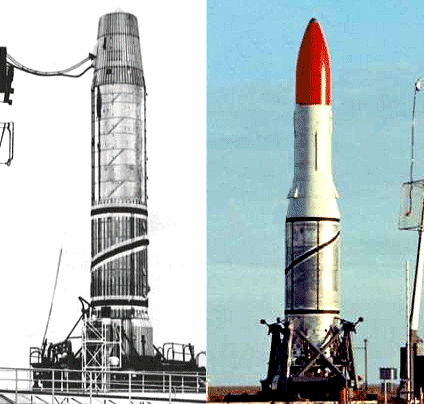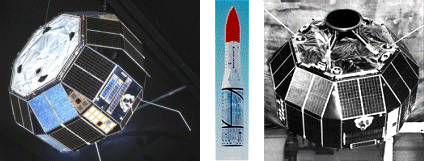|
|
The
Space Age
The world entered the 'space age' on 4th October 1957 at 19:28:34
UTC (GMT) with the launch of the Sputnik 1 rocket and satellite (designated
PS1) into low earth orbit by the Soviet Union and the 'race for space'
was on. The second core stage of the R-7 Semyorka launch vehicle remained
in a decaying orbit for two months until 2nd December 1957.
Sputnik had a diameter of 22ins, weighed 184lbs and circled the Earth
once every 96minutes. Travelling at 18,000 miles an hour, its elliptical
orbit had a farthest point (apogee) of 584 miles and a nearest point
(perigee) of 143 miles and it was visible with binoculars before sunrise
and after sunset. Sputnik transmitted radio signals strong enough
to be picked up by amateur radio operators for 22 days, until its
batteries ran out on 26th October, and it burned up on atmospheric
re-entry after completing 1,440 orbits, a distance of about 43.5 million
miles. Hear Sputnik
A second spacecraft was launched into Earth orbit by the U.S.S.R.
on November 3rd 1957 and was the first to carry a live animal into
orbit. Three dogs were trained for the flight: Albina, Mushka and
a part-Samoyed female mongrel dog re-named Laika ('Barker'), originally
a stray dog from the streets of Moscow, who was finally selected.
Although the animal's 'mission' was planned to last ten days, on reaching
orbit the vehicle's interior temperature rapidly climbed to over 40°C
(100 °F) and Laika survived for only a few hours.
Sputnik 2 burned up on re-entry into Earth's atmosphere on 14th April
1958 after 162 days and 2,570 orbits. The Sputnik 2 flight caused
a major public outcry against the use, and killing, of animals in
experiments in general and spaceflight in particular.
As one result (although more likely a natural progression), future
space flights carrying dogs were designed to be recovered. The only
other dogs definitely known to have died during Soviet space missions
were Pchyolka and Mushka, when Sputnik 3 was purposely destroyed with
explosives to prevent foreign powers examining the capsule when its
re-entry trajectory went off target on December 1st 1960. |
|
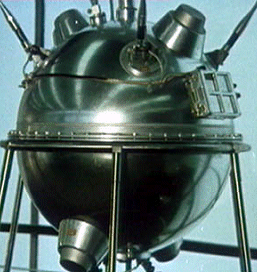 |
The news of these successes
were a surprise and shock to the American public and became an immediate
cause of concern for both national pride and, at the heart of the
'cold war', was perceived as a significant defence issue as the R-7
rocket was actually designated as an ICBM capable of delivering nuclear
warheads. It prompted a vigorous response from the American government
to ensure that the United States did not, technologically, fall behind
its Communist rival.
The Race For Space
The Americans joined the 'space race' on January 31st 1958 at 22:48
Eastern Time (February 1st 03:48 UTC) when a Juno LC-26 booster was
launched by the U.S. Army from Cape Canaveral carrying the Explorer
1 satellite into orbit as part of U.S. participation in the International
Geophysical Year. The 30lb satellite remained in orbit until 1970
and was responsible for discovering the existence of the Van Allen
radiation belts.
On October 1st 1958 NASA (National Aeronautics and Space Administration)
was created to replace the National Advisory Committee on Aeronautics
and remove any obvious direct involvement with the U.S. armed forces.
The Project
Mercury manned space program, formed under the administration
of President Dwight D. Eisenhower, was officially approved on October
7th 1958 and publicly announced on December 17th. Its goal was to
put a functional, manned spacecraft into orbit, before the Soviet
Union, and retrieve it successfully and safely.
1959 proved to be quite an eventful year for the Soviets, starting
with the Luna 1 launch on January 2nd. Intended to hit the moon, it
missed and was the first man-made object to achieve solar orbit. Luna
2, launched on September 12th, was more successful and, the following
day, became the first man-made object to impact the lunar surface.
October 4th saw the launch of Luna 3 which achieved lunar orbit and
gave us the first images of 'the dark side' that always faces away
from the Earth. |
The
Mercury Program
Although NASA originally intended open competition to choose its first
astronauts, Eisenhower insisted on existing test pilots. Limited space
inside the Mercury capsule restricted a candidates' height to 5ft
11ins and a maximum weight of 180lbs (82 kg). They had to be under
40, holding a bachelor's degree, or equivalent, and have jet flying
experience with at least 1,500 hrs flying time logged.
The initial advertisement among military test pilots attracted more
than 500 applications, from which NASA selected 110 'possibles' -
5 Marines, 47 Navy and 58 Air Force. The conditions at that time excluded
NACA's X-15 test pilot Neil Armstrong as he was a civilian. These
were divided into three groups, of which only two groups - sixty-nine
men - were subjected to extensive physical stress tests and mental
exams, including hours on treadmills and tilt tables, extended submersion
of feet in ice water, doses of castor oil and multiple enemas. The
final group was never assessed due to the high qualification rate
from the first two.
Of the 69, 6 were rejected as being too tall, 33 failed, or dropped
out, during the first round of tests and 4 declined to take part in
further tests, leaving 26, of which 18 passed the second round of
tests. The seven men, known as the 'Mercury 7' hence the '7' after
the vehicle names, finally picked for the Mercury program were:
Alan Bartlett Shepard Jr. (1923-1998) U.S. Navy (2 space flights)
MR-3 (Freedom 7) - May 1961 First manned Mercury flight.
Shepard became the first American in space
Apollo 14 - January 1971 - Commander Third manned lunar landing. Shepard
became the 5th man to walk on the moon
Virgil Ivan 'Gus' Grissom (1926-1967) U.S. Air Force (2 space flights)
MR-4 (Liberty Bell 7) - July 1961 The last suborbital Mercury flight.
Liberty Bell 7 sank after splashdown and was not retrieved until 1999
Gemini 3 - March 1965 - Command Pilot First manned Gemini mission,
first manned mission to change orbital plane. Grissom became the first
person to be launched into space twice. He was to be the commander
of Apollo 1 but was killed in a fire during a launch pad test in January
1967, a month before the mission.
John Herschel Glenn Jr. (b 1921) U.S. Marine Corps (2 space flights)
MA-6 (Friendship
7) - February 1962 First orbital Mercury flight. Glenn became
the first American to orbit the Earth
STS-95 Discovery Spacelab mission - October 1998 Glenn became the
oldest person in space on this flight.
Malcolm Scott Carpenter (1925-2013) U.S. Navy (1 space flight)
MA-7 (Aurora 7) - May 1962 Second orbital Mercury mission
Walter Marty 'Wally' Schirra Jr. (1923-2007) U.S. Navy (3 space flights)
MA-8 (Sigma 7) - October 1962 Third orbital Mercury flight
Gemini 6A - December 1965 - Command Pilot First rendezvous in space,
with Gemini 7
Apollo 7 - October 1968 - Commander First manned Apollo mission. Schirra
became the first person to be launched into space three times and
the only person to fly Mercury, Gemini, and Apollo missions.
Leroy Gordon 'Gordo' Cooper Jr. (1927-2004) U.S. Air Force (2 space
flights)
MA-9 (Faith 7) - May 1963 Final Mercury mission and the first U.S.
mission to exceed one day
Gemini 5 - August 1965 - Command Pilot First 8-day space mission and
first use of fuel cells for electric power
Donald Kent 'Deke' Slayton (1924-1993) U.S. Air Force (1 space flight)
Apollo-Soyuz Test Project - July 1975 - Docking Module Pilot First
joint American-Soviet space mission and the first docking of an American
and Russian spacecraft.
Despite the extensive testing and medical examinations, two were subsequently
found to have undiagnosed medical conditions. Slayton never took part
in Mercury missions as an astronaut and Shepard was grounded after
the Mercury program. The start of the Sixties saw manned spaceflight
change from being the subject of science fiction stories in boys'
comics into startling, exciting, scientific fact.
Prior to 1960 there had been a number of experimental vehicles launched
but flights involving animals had been comparatively unsuccessful
and inconclusive. Even when the Russians managed to put two Samoyed
dogs, Belka and Strelka, into orbit for 24 hours in August 1960, and
brought them back alive, it was still questionable whether human spaceflight
would be possible.
|
|
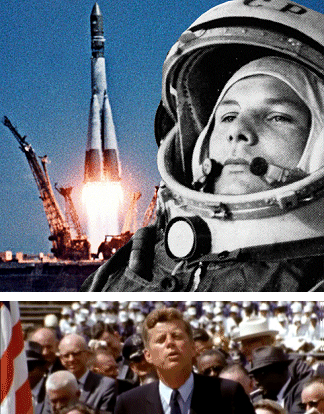

|
Mankind
In Orbit
The American attempts to achieve technological 'one-upmanship' received
another blow on 12th April 1961 when Major Yuri Alexeyevich Gagarin
blasted off at 07:07 hrs from the Baikonur site in Siberia, aboard
the Vostok 1 3KA-3, shortly afterwards officially becoming the first
human to travel into space, and the first to actually orbit the earth
and return safely.
Gagarin had to bail out and land using his parachute as the Vostok
1 was designed to crash land. The Russians are believed to have made
four unsuccessful manned space shots prior to 1961 in which it is
thought that cosmonauts Serentsky Schiborin, Andrei Mitkov, Alexis
Ledovski and Ivan Kachur lost their lives. (See Soviet Page)
Just a month later, on May 5th 1961, Alan Shepard became the second
person in space, and the first American, in a suborbital flight. The
MR-3 (Freedom 7) launch was originally planned for October 1960 but
was postponed several times, eventually to March 6th 1961 and, finally,
to May 5th by which time it had been pre-empted by the Soviets. Virgil
'Gus' Grissom also carried out a sub-orbital flight.
The new American President, John F. Kennedy, understood the nation's
need to restore their pride and confidence and publicly stated his
intention to not just follow and keep pace with the Soviets, but to
overtake them. On May 25th 1961 he addressed Congress with a request
for an additional $7 billion to $9 billion, over the next five years,
for the development of the U.S. space program with the words "...
this nation should commit itself to achieving the goal, before the
decade is out, of landing a man on the moon and returning him safely
to the earth."
JFK
'Space Speech' at Rice University 1962
Despite scepticism on NASA's ability to deliver, the money was granted
and, within a year, America had put its own man into orbit. Astronaut
John Glenn became the first American to achieve Earth orbit on February
20th 1962. He was the third person to do so, as Soviet cosmonaut Gherman
Titov had, by then, made a one-day flight during August 1961. Launched
from Cape Canaveral, Florida, Friendship 7 achieved an altitude of
162 miles and an orbital velocity of 17,500 mph. It circled Earth
three times in four hours and eventually splashed down in the Atlantic
Ocean near Bermuda.
By the time the Mercury single pilot project ended with a day-long
22-orbit flight on May 16th 1963, being replaced by the Gemini two-man
program, astronauts Scott Carpenter, Walter Schirra Jr., and L. Gordon
Cooper had also orbited the Earth in increasingly extended mission
times.
The Soviets launched Vostok 5 on 14th June 1963, piloted by Valery
Bykovsky. This was followed, two days later, by the launch of Vostok
6 in which Valentina Tereshkova became the first woman into space,
achieving 48 orbits over two days, twenty-two hours and fifty minutes,
despite a number of technical issues and the limited space within
her capsule. In this, the last of the Vostok missions, she actually
logged more flight time than all the previous American astronauts
combined. At one point the two Soviet space vehicles were within about
three miles of each other.
Male Russian cosmonauts always had one 'double' appointed but Valentina
Tereshkova had two of them - Valentina Ponomareva and Irina Solovyova.
The State Commission justified this by saying that the female body
was worse than the load. After receiving the same training programmes
as the main participant of the events, the 'doubles' after Tereshkova’s
flight not only did not receive any honours but generally remained
unknoen and secret figures for a very long time.
Valentina Leonidovna Ponomareva:
“For many people of our generation, the flight of Valentina Tereshkova
to space meant no less, and perhaps even more, than the flight of
Gagarin. For us, members of the first women's group of cosmonauts,
this has become the crown of a lifetime. I think I will not be mistaken
in saying that the period until the group existed was for us all the
most dramatic, the brightest, the most significant and the most difficult.
A huge number of people and events of world significance fit in it"
In addition to the manned missions,
Mercury performed 20 unmanned launches for project development, some
including test animals, the most famous of which were the chimpanzees
Ham and Enos.
|
The United States
and the U.S.S.R. spent huge amounts of money trying to outdo
each other in the 'race for space', a contest which drove scientific
advancement along at a phenomenal pace, providing new materials
and technologies such as 'Teflon' and the laser. The spaceflight
programme also brought us new heroes, tragedy and excitement.
The Gemini Program
Project Gemini carried out two unmanned flights, in 1964 and
1965, followed by ten manned flights, in 1965 and 1966, with
the objectives of improving re-entry techniques, developing
orbital manoeuvres, EVAs and link-ups and further examining
the effects of prolonged spaceflight on the human body in support
of the planned subsequent Apollo program.
All Gemini missions were launched from Cape Canaveral and used
the Titan II 'GLV' launch vehicle. The Soviets carried out the
first 'space walk' on March 18th 1965 when Voskhod 2, manned
by Commander Pavel I. Belyayeu and Pilot Alexei A. Leonov, saw
the latter achieve a 12-minute EVA outside of the orbiting craft.
Sixteen American astronauts flew on the 10 manned Gemini missions,
only 3 of whom had been involved with the Mercury program:
Leroy Gordon Cooper Jr. (Gemini 5 Command Pilot)
Virgil Ivan 'Gus' Grissom (Gemini 3 Command Pilot)
Walter Marty 'Wally' Schirra Jr. (Gemini 6A Command Pilot)
The 'new boys' were:
Neil A. Armstrong (Gemini 8 Command Pilot), Frank Borman (Gemini
7 Command Pilot)
Charles 'Pete' Conrad (Gemini 5 Pilot and Gemini 11 Command
Pilot), James A. Lovell (Gemini 7 Pilot and Gemini 12 Command
Pilot)
James A. McDivitt (Gemini 4 Command Pilot), Thomas P. Stafford
(Gemini 6A Pilot and Gemini 9 Command Pilot)
Edward H. White II (Gemini 4 Pilot), John W. Young (Gemini 3
Pilot and Gemini 10 Command Pilot)
Edwin 'Buzz' Aldrin (Gemini 12 Pilot), Eugene A. Cernan (Gemini
9 Pilot), Michael Collins (Gemini 10 Pilot)
Richard F. Gordon (Gemini 11 Pilot), David R. Scott (Gemini
8 Pilot)
Gemini 3 March 23rd 1965 - the seventh manned US spaceflight,
and the final manned flight controlled from Cape Canaveral,
Florida before mission control was moved to Houston, Texas.
Gemini 4 June 3rd 1965 - Edward H. White became the first American
to make a 'space walk' (EVA - extravehicular activity).
Gemini 5 carried out the 8-day endurance tests in support of
the planned Apollo lunar mission using fuel cells to generate
electrical power.
Gemini 6A and 7 carried out the first space rendezvous, in December
1965, with Gemini 7 setting a 14-day space endurance record.
Gemini 8 carried out the first space docking with an unmanned
Agena Target Vehicle.
Gemini 11 achieved a manned Earth orbit altitude record of 739.2
nautical miles in September 1966 by using the propulsion system
of its Agena target vehicle.
Gemini 12 Edwin 'Buzz' Aldrin was the first astronaut to prove
that significant useful work could be undertaken outside of
a spacecraft, without life-threatening exhaustion. |
|
|
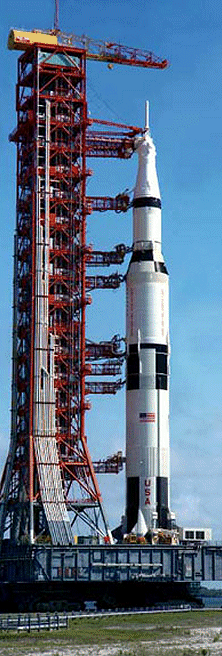 |
Apollo
- Reaching For The Moon
As space exploration continued through the 1960s, the United States
was on its way to the Moon. The Apollo 3-man Program followed Project
Gemini. Its sole goal was to land humans on the moon and assure their
safe return to Earth. The Apollo missions and astronauts were:
AS-201 February 26th 1966 Crew: None
First unmanned flight of Saturn 1B and Block 1 CSM Sub-orbital flight
to test ablative heat shield at orbital re-entry speed
AS-203 July 5th 1966 Crew: None
Unmanned observations of the behaviour of liquid hydrogen fuel in
orbit to support design of S-IVB re-start capability
AS-202 August 25th 1966 Crew: None
Unmanned sub-orbital flight of CSM
On January 27th 1967 a tragedy occurred when, during a routine test
of the 'Apollo 1' spacecraft on the launch pad, an electrical spark
caused a fire in the crew compartment of the command module. The pure
oxygen environment in the capsule led to rapid spreading of the fire,
causing the deaths of Gus Grissom, Ed White, and Roger Chaffee.
The Soviets suffered their own tragedy three months later on April
24th when Soyuz 1, launched the previous day, crashed after re-entry
killing pilot Vladimir M. Komarov, the first 'official' Soviet spaceflight
fatality.
Apollo 4 November 9th 1967 Crew: None
First unmanned test flight of Saturn V to place a CSM in a high Earth
orbit. Testing of S-IVB re-start capability and CM heat shield at
lunar re-entry speed
Apollo 5 January 22nd-23rd 1968 Crew: None
First unmanned Earth orbital flight of LM, to test ascent/descent
propulsion and human support, launched on Saturn 1B
On March 27th 1968, the star that was Yuri Gagarin disappeared from
the sky as he died in a mysterious
air accident.
Apollo 6 April 4th 1968 Crew: None
Attempted test of trans-lunar injection and direct-return abort with
SM engine. Three engine failures prevented the S-IVB restart. Flight
control used SM engine to repeat the Apollo 4 flight profile.
Apollo 7 October 11th-22nd 1968 Crew: Walter Schirra, Walt Cunningham
and Don Eisele
First manned Earth orbital demonstration of Block II CSM, launched
on Saturn 1B. First live public television broadcast from a manned
mission
Apollo 8 December 21st-27th 1968 Crew: Frank Borman, James Lovell,
William Anders
First manned flight to the Moon. The CSM made 10 lunar orbits over
20 hours
Apollo 9 March 3rd-13th 1969 Crew: James McDivitt, David Scott, Russell
Schweickart
First manned flight of CSM and LM in Earth orbit, testing the Portable
Life Support System to be used on the lunar surface
Apollo 10 May 18th-26th 1969 Crew: Thomas Stafford, John Young, Eugene
Cernan
Dress rehearsal for the first lunar landing. LM taken down to 50,000
feet (15 km) from lunar surface
Apollo 11 July 16th-24th 1969 Crew: Neil Armstrong, Michael Collins,
Buzz Aldrin
First manned moon landing. Surface EVA time: 2hrs 31mins 47.7lbs of
rock samples collected |
The first manned lunar
landing took place on the Sea of Tranquillity at 02:56 GMT on 20th
July 1969. Neil Armstrong became the first man to walk on the surface
of the moon, at 03:56 BST on 21st July 1969, causing millions of us
to stay up all night watching the television reports and live television
coverage. "That's one small step for [a] man, one giant leap for mankind".
He was joined by his colleague Edwin 'Buzz' Aldrin at 03:15 GMT
Prior to the Apollo 11 mission, both the USA and USSR were busy sending
unmanned exploratory craft and objects to the lunar surface (either
successfully or not) and there were already 31 man-made items on the
surface (including his own craft) when Neil Armstrong took his first
step.
Apollo 12 November 14th-24th 1969 Crew: Charles 'Pete' Conrad, Richard
Gordon, Alan L. Bean
The second lunar landing, in the Ocean of Storms very near to the
Surveyor 3 craft. Surface EVA time: 7hrs 45mins 75.7lbs of rock samples
collected This was the last U.S. space flight of the 1960s
Apollo 13 April 11th-17th, 1970 Crew: James Lovell, Jack Swigert,
Fred Haise
The third lunar landing attempt was aborted near the Moon, due to
a Service Module failure. The crew used the Landing Module to return
to Earth, as documented in the feature film.
Apollo 14 January 31st-February 9th 1971 Crew: Alan Shepard, Stuart
Roosa, Edgar Mitchell
The third lunar landing, in Fra Mauro. Surface EVA time: 9hrs 21mins
94.4lbs of rock samples collected
Apollo 15 July 26th-August 7th 1971 Crew: David Scott, Alfred Worden,
James Irwin
The fourth lunar landing, and the first with an extended LM and 'lunar
rover', landed in Hadley-Apennine. Surface EVA time: 18hrs 33mins
169lbs of rock samples collected
Apollo 16 April 16th-27th 1972 Crew: John Young, T. Kenneth Mattingly,
Charles Duke
The fifth lunar landing, in Plain of Descartes. Surface EVA time:
20hrs 14mins 208.3lbs of rock samples collected
Apollo 17 December 7th-19th 1972 Crew: Eugene Cernan, Ronald Evans,
Harrison Schmitt
The sixth and last lunar landing, and final Apollo mission, landed
in Taurus-Littrow. Surface EVA time: 22hrs 2mins 243.1lbs of rock
samples collected.
The original estimate of Apollo Program costs was $7billion. The final
cost of the project was reported to Congress in 1973 was $25.4 billion
but later, in 2009, NASA recalculated the cost taking into account
all ancillary equipment and 'soft' costs, coming up with a total estimate
of c. $170 billion.
This made 'moon rock' the most valuable commodity on Earth. With 838.2lbs
collected, this works out at about $12.7million per ounce or $447,289
per gram!
Space Junk
Vanguard 1, America's second satellite, still remains in orbit
from March 17th 1958, orbiting the Earth at about 2,400 miles.
Their first satellite, Explorer 1, launched on February 1st 1958,
fell from orbit in 1970. The first two Soviet Sputniks, launched in
October and November of 1957, came down in 1958. The number now constantly
varies, but as of 2000, the total number of working payloads and useless
debris (anything from grapefruit-size upwards that can be tracked
by ground radar) to enter orbit since 1957 was 25,976. Of those, 2,742
payloads and 5,991 pieces of junk were still in orbit with the remainder
having re-entered the atmosphere and (mostly!) burned up. |
|
|


